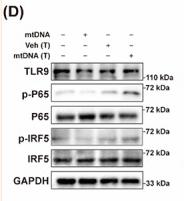Phospho-IRF5 (Ser437) Antibody - #AF8382
| Product: | Phospho-IRF5 (Ser437) Antibody |
| Catalog: | AF8382 |
| Description: | Rabbit polyclonal antibody to Phospho-IRF5 (Ser437) |
| Application: | WB IHC IF/ICC |
| Cited expt.: | WB |
| Reactivity: | Human, Mouse, Rat |
| Prediction: | Pig, Zebrafish, Bovine, Horse, Sheep, Rabbit, Dog, Chicken, Xenopus |
| Mol.Wt.: | 56kDa; 56kD(Calculated). |
| Uniprot: | Q13568 |
| RRID: | AB_2840443 |
Related Downloads
Protocols
Product Info
*The optimal dilutions should be determined by the end user. For optimal experimental results, antibody reuse is not recommended.
*Tips:
WB: For western blot detection of denatured protein samples. IHC: For immunohistochemical detection of paraffin sections (IHC-p) or frozen sections (IHC-f) of tissue samples. IF/ICC: For immunofluorescence detection of cell samples. ELISA(peptide): For ELISA detection of antigenic peptide.
Cite Format: Affinity Biosciences Cat# AF8382, RRID:AB_2840443.
Fold/Unfold
Interferon regulatory factor 5; Interferon regulatory factor 5 bone marrow variant; IRF 5; IRF-5; Irf5; IRF5_HUMAN; SLEB10;
Immunogens
A synthesized peptide derived from human IRF5 around the phosphorylation site of Ser437.
- Q13568 IRF5_HUMAN:
- Protein BLAST With
- NCBI/
- ExPASy/
- Uniprot
MNQSIPVAPTPPRRVRLKPWLVAQVNSCQYPGLQWVNGEKKLFCIPWRHATRHGPSQDGDNTIFKAWAKETGKYTEGVDEADPAKWKANLRCALNKSRDFRLIYDGPRDMPPQPYKIYEVCSNGPAPTDSQPPEDYSFGAGEEEEEEEELQRMLPSLSLTEDVKWPPTLQPPTLRPPTLQPPTLQPPVVLGPPAPDPSPLAPPPGNPAGFRELLSEVLEPGPLPASLPPAGEQLLPDLLISPHMLPLTDLEIKFQYRGRPPRALTISNPHGCRLFYSQLEATQEQVELFGPISLEQVRFPSPEDIPSDKQRFYTNQLLDVLDRGLILQLQGQDLYAIRLCQCKVFWSGPCASAHDSCPNPIQREVKTKLFSLEHFLNELILFQKGQTNTPPPFEIFFCFGEEWPDRKPREKKLITVQVVPVAARLLLEMFSGELSWSADSIRLQISNPDLKDRMVEQFKELHHIWQSQQRLQPVAQAPPGAGLGVGQGPWPMHPAGMQ
Predictions
Score>80(red) has high confidence and is suggested to be used for WB detection. *The prediction model is mainly based on the alignment of immunogen sequences, the results are for reference only, not as the basis of quality assurance.
High(score>80) Medium(80>score>50) Low(score<50) No confidence
Research Backgrounds
Transcription factor involved in the induction of interferons IFNA and INFB and inflammatory cytokines upon virus infection. Activated by TLR7 or TLR8 signaling.
Phosphorylation of serine and threonine residues in a C-terminal autoinhibitory region, stimulates dimerization, transport into the nucleus, assembly with the coactivator CBP/p300 and initiation of transcription.
'Lys-63'-linked polyubiquitination by TRAF6 is required for activation.
Cytoplasm. Nucleus.
Note: Shuttles between the nucleus and the cytoplasm.
Belongs to the IRF family.
Research Fields
· Organismal Systems > Immune system > Toll-like receptor signaling pathway. (View pathway)
References
Application: WB Species: Mice Sample: BMDCs
Restrictive clause
Affinity Biosciences tests all products strictly. Citations are provided as a resource for additional applications that have not been validated by Affinity Biosciences. Please choose the appropriate format for each application and consult Materials and Methods sections for additional details about the use of any product in these publications.
For Research Use Only.
Not for use in diagnostic or therapeutic procedures. Not for resale. Not for distribution without written consent. Affinity Biosciences will not be held responsible for patent infringement or other violations that may occur with the use of our products. Affinity Biosciences, Affinity Biosciences Logo and all other trademarks are the property of Affinity Biosciences LTD.



